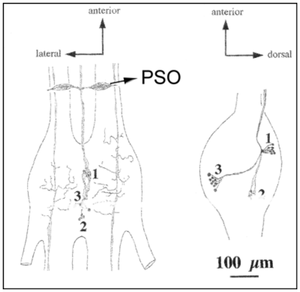anti-PVK
anti-Periviscerokinin
rabbit, polyclonal
| Catálogo Nº | Apresentação | Preço (R$) | Comprar / Observação |
|---|---|---|---|
| ABD-065 | 100 μl | Sob demanda | Adicionar ao Carrinho |

Fig. 1

Fig. 2: Example for the specificity of the anti-periviscerokinin-serum. Note the immunoreactive neurons in the ventral nerve cord of larval Drosophila melanogaster.
For general laboratory use.
Envio: shipped on gel packs
Condições de armazenamento: store at -20 °C
avoid freeze/thaw cycles
Validade: 12 months
Forma: liquid (Supplied as serum, preserved in glycerol)
Formulários:
Anti-Periviscerokinin can be used for ELISA and Immunocytochemistry.
Descrição:
The anti-periviscerokinin serum was raised against the Periplaneta americana periviscerokinin-1 (Predel et.al. 1995), GASGLIPVMRNamide (PVK-1), coupled to bovine thyroglobulin using glutaraldehyde. PVK-1 is one of 24 different neuropeptides of the FMR Famide gene (Predel et.al. 2004).
Specificity:
In agreement with the mass spectrometric methods (Predel et al.2004) revealed immunocytochemical methods a tagma specific distribution of periviscerokinin-1-immunoreactivity exclusively
in the abdominal perisympathetic organs but never in thoracic PSO or the retrocerebral complex of Periplaneta americana (Fig 1: PSO of third abdominal ganglia). In the contrary a anti-PVK-1- immunoreactivity is displayed in the thoracic PSOs of the ventral nerve cord from larval Drosophila melanogaster (Fig 2).
Referências selecionadas:
Predel et al. (2004) Unique accumulation of neuropeptides in an insect: FMRFamide-related peptides in the cockroach, Periplaneta americana. Eur J Neurosci. 6:1499.
Predel et al. (1995) Periviscerokinin (Pea-PVK): A novel myotropic neuropeptide from the perisympathetic organs of the American cockroach. Peptides 16: 61.
